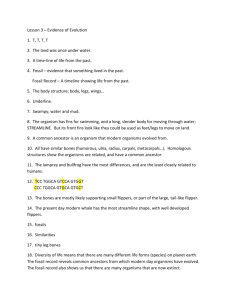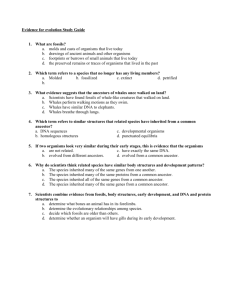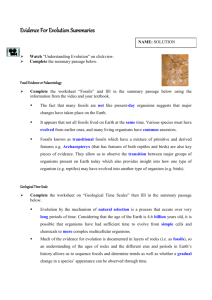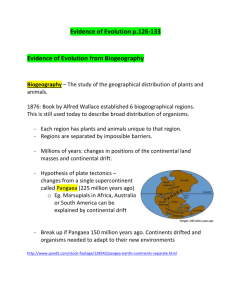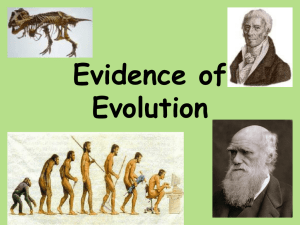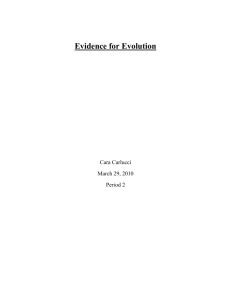13 - Cloudfront.net
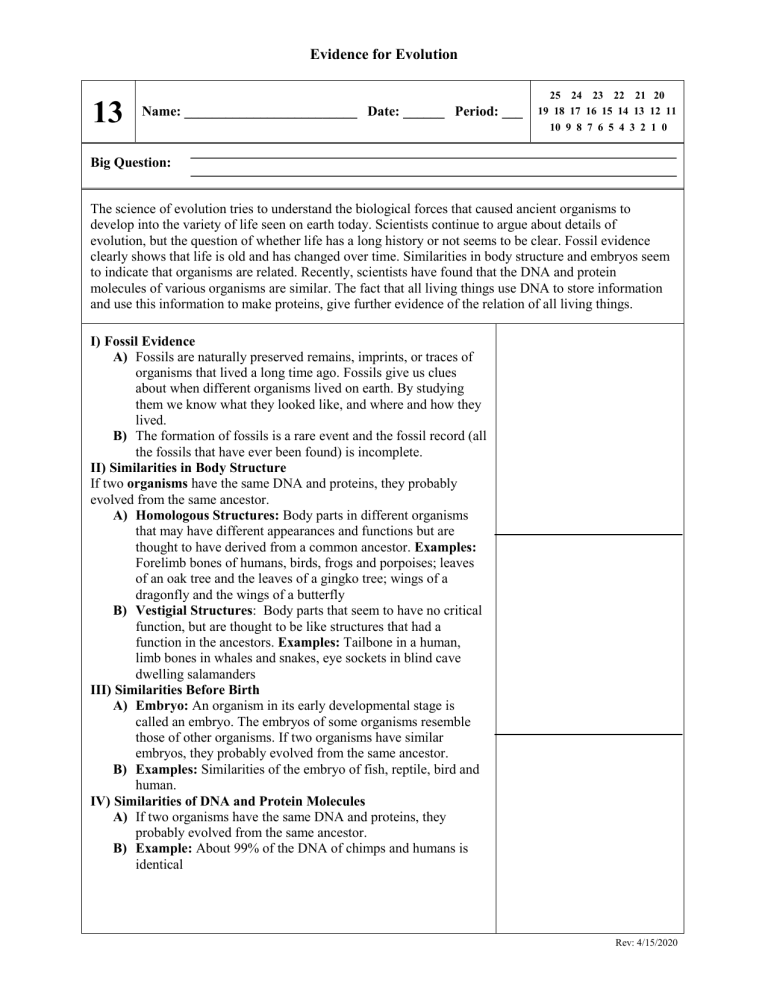
Evidence for Evolution
13
Name: _________________________ Date: ______ Period: ___
25 24 23 22 21 20
19 18 17 16 15 14 13 12 11
10 9 8 7 6 5 4 3 2 1 0
Big Question:
The science of evolution tries to understand the biological forces that caused ancient organisms to develop into the variety of life seen on earth today. Scientists continue to argue about details of evolution, but the question of whether life has a long history or not seems to be clear. Fossil evidence clearly shows that life is old and has changed over time. Similarities in body structure and embryos seem to indicate that organisms are related. Recently, scientists have found that the DNA and protein molecules of various organisms are similar. The fact that all living things use DNA to store information and use this information to make proteins, give further evidence of the relation of all living things.
I) Fossil Evidence
A) Fossils are naturally preserved remains, imprints, or traces of organisms that lived a long time ago. Fossils give us clues about when different organisms lived on earth. By studying them we know what they looked like, and where and how they lived.
B) The formation of fossils is a rare event and the fossil record (all the fossils that have ever been found) is incomplete.
II) Similarities in Body Structure
If two organisms have the same DNA and proteins, they probably evolved from the same ancestor.
A) Homologous Structures: Body parts in different organisms that may have different appearances and functions but are thought to have derived from a common ancestor. Examples:
Forelimb bones of humans, birds, frogs and porpoises; leaves of an oak tree and the leaves of a gingko tree; wings of a dragonfly and the wings of a butterfly
B) Vestigial Structures : Body parts that seem to have no critical function, but are thought to be like structures that had a function in the ancestors. Examples: Tailbone in a human, limb bones in whales and snakes, eye sockets in blind cave dwelling salamanders
III) Similarities Before Birth
A) Embryo: An organism in its early developmental stage is called an embryo. The embryos of some organisms resemble those of other organisms. If two organisms have similar embryos, they probably evolved from the same ancestor.
B) Examples: Similarities of the embryo of fish, reptile, bird and human.
IV) Similarities of DNA and Protein Molecules
A) If two organisms have the same DNA and proteins, they probably evolved from the same ancestor.
B) Example: About 99% of the DNA of chimps and humans is identical
Rev: 4/15/2020
Evidence for Evolution
1.
Similar body structures that related species have inherited from a common ancestor are called
________________________.
2.
Scientists compare DNA and protein molecules to find out how _________________ are related.
A) species
B) habitats
C) fossils
3.
Which of the following can be a fossil? Circle all that apply.
A) Footprints
B) Bones
C) Animal shells
5.
True or False: Fossil record is complete and gives us no doubt that evolution has happened on earth.
4.
_______________ structures are body parts that resemble one another in different species, not because they have evolved from a common ancestor, but because they evolved independently as adaptations to their environments.
6.
An organism in its early development is called a(n) _____________________.
7.
__________________ structures are body parts that seem to have had critical functions in the body of the ancestor but no critical function in the body of the current organism.
9.
True or False: The body of a human has no similarities with the body of a fish.
8.
Organisms that are more closely related are thought to have more similarities in their
_________________. Circle all that apply.
A) DNA molecules
B) Proteins molecules
C) Body structures
10.
True or False: The formation of fossils is a common event.
10 9 8 7 6 5 4 3 2 1 0
Mini-Essay (10 pts) Read, Understand, and Answer: Scientists have discovered fossils of ancient whale-like organisms that had legs instead of flippers. What does this evidence most likely indicate about whales? Explain. What does this evidence most likely indicate about how evolution occurs?
Explain.
______________________________________________________________________________
______________________________________________________________________________
______________________________________________________________________________
______________________________________________________________________________
______________________________________________________________________________
______________________________________________________________________________
______________________________________________________________________________
______________________________________________________________________________
______________________________________________________________________________
______________________________________________________________________________
______________________________________________________________________________
______________________________________________________________________________
Honest and fair self-evaluation helps you improve.
You are evaluating the work of the person
NOT the person.
If your handwriting is hard to read, maximum score is 5. You can type your essay and paste in the space.
Rev: 4/15/2020


